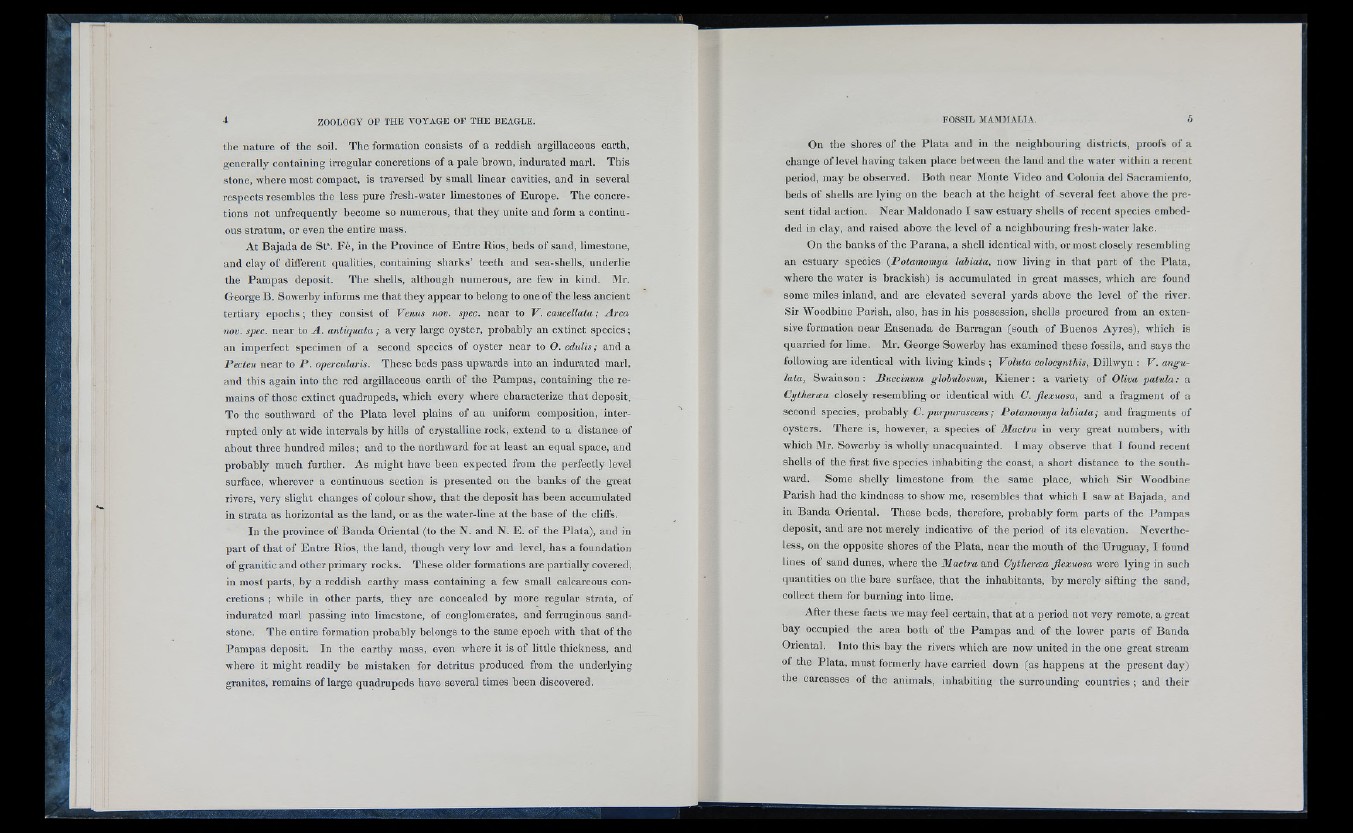
tlie nature o f the soil. The formation consists o f a reddish argillaceous earth,
generally containing irregular concretions o f a pale brown, indurated marl. This
stone, where most compact, is traversed by small linear cavities, and in several
respects resembles the le ss pure fresh-water limestones o f Europe. The concretions
not unfrequently become so numerous, that they unite and form a continuous
stratum, or even the entire mass.
At Bajada de St". F e , in the Province o f Entre Rios, beds o f sand, limestone,
and clay o f different qualities, containing sharks’ teeth and sea-shells, underlie
the Pampas deposit. The shells, although numerous, are few in kind. Mr.
George B . Sowerby informs me that they appear to belong to one o f the le ss ancient
tertiary ep o ch s ; they consist o f Venus nov. spec, near to V. cancellata; A tx a
nov. spec, near to A . an tiqu a ta ; a very large oyster, probably an extinct spe cie s;
an imperfect specimen o f a second spe cie s o f oyster near to O. edulis; and a
Pecten near to P . opercularis. These beds pass upwards into an indurated marl,
and this again into the red argillaceous earth o f the Pampas, containing the remains
o f those extinct quadrupeds, which every where characterize that deposit.
To the southward o f the Pla ta level plains o f an uniform composition, interrupted
only at wide intervals b y hills o f crystalline rock, extend to a distance o f
about three hundred m ile s ; and to the northward for at least an equal space, and
probably much further. As might have been expected from the perfectly level
surface, wherever a continuous section is presented on the banks o f the great
rivers, very slight changes o f colour show, that the deposit has been accumulated
in strata as horizontal as the land, or as the water-line at the base of the cliffs.
In the province o f Banda Oriental (to the N . and N . E . o f the Plata), and in
part o f that o f Entre Rios, the land, though very low and level, has a foundation
o f granitic and other primary rocks. These older formations are partially covered,
in most parts, b y a reddish earthy mass containing a few small calcareous concretions
; while in other parts, they are concealed by more regular strata, of
indurated marl p assing into limestone, o f conglomerates, and ferruginous sandstone.
Th e entire formation jirobably belongs to the same epoch with that o f the
Pampas deposit. In tlie earthy mass, even where it is o f little thickness, and
where it might readily be mistaken for detritus produced from the underlying
granites, remains o f large quadrupeds have several times been discovered.
On the shores of the P la ta and in the neighbouring districts, proofs o f a
change o f level having taken place between the land and the water within a recent
period, may be observed. Both near Monte Video and Colonia del Sacramiento,
beds o f she lls are ly ing on the beach at the height o f several feet above tlie present
tidal action. Near Maldonado I saw estuary she lls o f recent spe cie s embedded
in clay, and raised above the level o f a neighbouring fresh-water lake.
On the banks o f the Parana, a shell identical with, or m ost closely resembling
an estuary spe cie s {Potamomya labiata, now living in that part o f the Plata,
where the water is brackish) is accumulated in great masses, which are found
some miles inland, and are elevated several yards above the level o f the river.
Sir Woodbine Parish, also, has in his possession, she lls procured from an ex ten sive
formation near Ensenada de Barragan (south o f Buenos Ayres), which is
quarried for lime. Mr. George Sowerby has examined these fossils, and says the
following are identical with living kinds ; Voluta colocynthis, Dillwyn : V . angu-
laia, Swainson : Buccinum globulosum, K ien e r : a variety o f Oliva p a tu la : a
Cythercea closely resembling or identical with C. Jiexuosa, and a fragment o f a
second species, probably C . purpurascens; Potamomya labiata; and fragments of
oysters. There is, however, a species o f Mactra in very great numbers, with
which Mr. Sowerby is wholly unacquainted. I may observe that I found recent
she lls o f the first five spe cie s inhabiting the coast, a short distance to the southward.
Some she lly limestone from the same place, which Sir Woodbine
Parish had the kindness to show me, resembles that which I saw at Bajada, and
in Banda Oriental. These beds, therefore, pi'obably form parts o f the Pampas
deposit, and are not merely indicative o f the period o f its elevation. Neverthele
ss, on the opposite shores of the Plata, near the mouth o f the Uruguay, I found
lines o f sand dunes, where the 31acira and Cythercea Jiexuosa were ly in g in such
quantities on the bare surface, that the inhabitants, by merely sifting the sand,
collect them for burning into lime.
After these facts we may feel certain, that at a period not very remote, a great
bay occupied the area both o f the Pampas and o f the lower parts o f Banda
Oriental. Into this b a y the rivers which are now united in the one great stream
ot the Plata, must formerly have carried down (as happens at the present day)
the carcasses o f the animals, inhabiting the surrounding countries ; and their